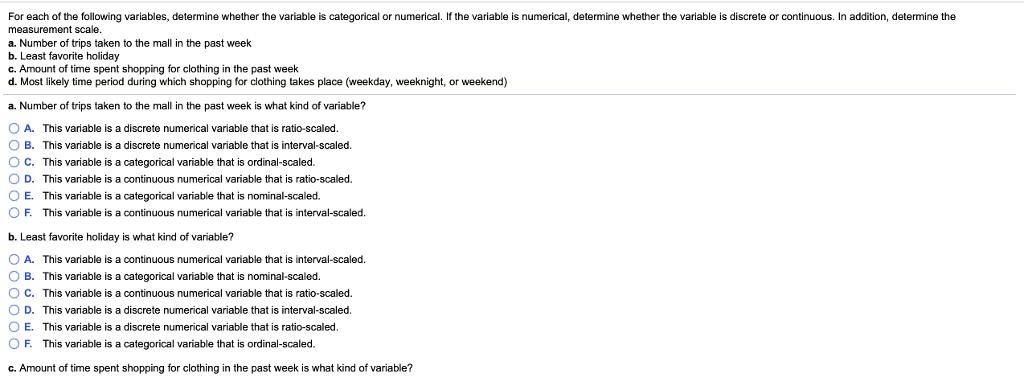Answered step by step
Verified Expert Solution
Question
1 Approved Answer
For each of the following variables, determine whether the variable is categorical or numerical. If the variable is numerical, determine whether the variable is


For each of the following variables, determine whether the variable is categorical or numerical. If the variable is numerical, determine whether the variable is discrete or continuous. In addition, determine the measurement scale. a. Number of trips taken to the mall in the past week b. Least favorite holiday c. Amount of time spent shopping for clothing in the past week d. Most likely time period during which shopping for clothing takes place (weekday, weeknight, or weekend) a. Number of trips taken to the mall in the past week is what kind of variable? O A. This variable is a discrete numerical variable that is ratio-scaled. OB. This variable is a discrete numerical variable that is interval-scaled. O C. This variable is a categorical variable that is ordinal-scaled. O D. This variable is a continuous numerical variable that is ratio-scaled. OE. This variable is a categorical variable that is nominal-scaled. F. This variable is a continuous numerical variable that is interval-scaled. b. Least favorite holiday is what kind of variable? A. This variable is a continuous numerical variable that is interval-scaled. OB. This variable is a categorical variable that is nominal-scaled. OC. This variable is a continuous numerical variable that is ratio-scaled. OD. This variable is a discrete numerical variable that is interval-scaled. OE. This variable is a discrete numerical variable that is ratio-scaled. OF F. This variable is a categorical variable that is ordinal-scaled. c. Amount of time spent shopping for clothing in the past week is what kind of variable? c. Amount of time spent shopping for clothing in the past week is what kind of variable? O A. This variable is a categorical variable that is nominal-scaled. OB. This variable is a discrete numerical variable that is ratio-scaled. OC. This variable is a continuous numerical variable that is ratio-scaled. OD. This variable is a discrete numerical variable that is interval-scaled. OE. This variable is a continuous numerical variable that is interval-scaled. OF. This variable is a categorical variable that is ordinal-scaled. d. Most likely time period during which shopping for clothing takes place what kind of variable? O A. This variable is a categorical variable that is nominal-scaled. OB. This variable is a continuous numerical variable that is interval-scaled. OC. This variable is a categorical variable that is ordinal-scaled. OD. This variable is a discrete numerical variable that is interval-scaled. O E. This variable is a discrete numerical variable that is ratio-scaled. OF. This variable is a continuous numerical variable that is ratio-scaled. Click o select your answer. ?
Step by Step Solution
★★★★★
3.38 Rating (167 Votes )
There are 3 Steps involved in it
Step: 1
The detailed answer for the above question is provided below To answer these questions we must determine whether the variables are categorical or nume...
Get Instant Access to Expert-Tailored Solutions
See step-by-step solutions with expert insights and AI powered tools for academic success
Step: 2

Step: 3

Ace Your Homework with AI
Get the answers you need in no time with our AI-driven, step-by-step assistance
Get Started


